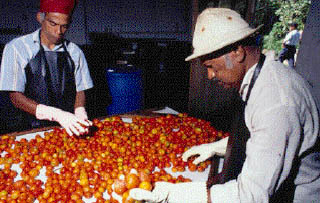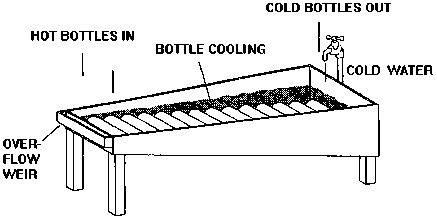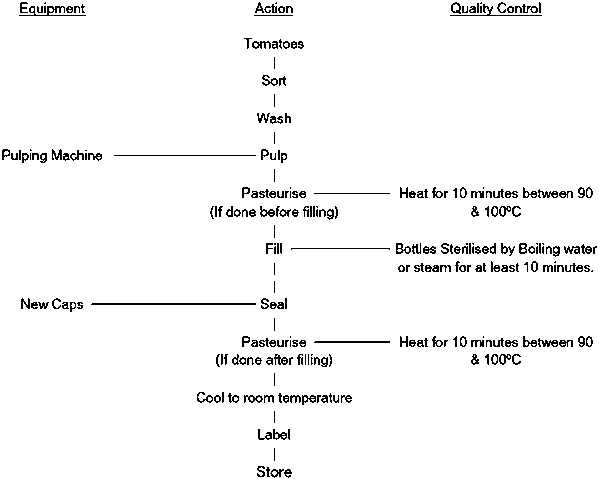Comment conserver les tomates
Sommaire
Description brève
- Problème:
- Idée:
- Difficulté:
- Game de prix:
- Matière nécessaire:
- Secteur géographique:
- Compétences:
- Combien de personnes?
- Combien de temps cela prend-il?
Traitement des tomates - Fiche technique
La technologie défie la pauvreté
Introduction
La demande de traitement de la tomate découle habituellement de la nécessité de conserver le produit pour la cuisine (ajout dans les ragoûts, soupes, currys, etc.) hors de la saison ou à ajouter de la valeur pour des revenus supplémentaires. Traditionnellement, les méthodes les plus importantes utilisées sont la concentration (en pâte ou purée) et le séchage des morceaux de fruits ou la transformation en poudre. Ceux-ci restent les procédés les plus appropriés pour de nombreuses personnes et constituent l'essentiel de cette fiche. Il convient de noter que normalement la haute qualité de « salades » de tomates a plus de valeur lorsque celles-ci sont vendues fraîches et en bon état. Elles ne sont pas normalement utilisées pour le traitement, sauf pour un usage domestique pour économiser l’excès à la haute saison.
Qualité des matières premières
Pour chacun des procédés décrits ci-dessous les tomates doivent être mûres, rouge, ferme à molle, libres de toutes moisissures (en coupant les parties infectées) et exemptes de tiges, de feuilles, de saletés et autres souillures (par le lavage). Ceci est moins important si les tomates ont des défauts à la surface ou des déchirures /fissures (à condition que celles-ci ne sont pas infectées) comme dans la plupart des traitements, elles seront coupées ou transformées en pulpe.
Traitement
Séchage
Les méthodes traditionnelles sont dans les régions chaudes et sèches comprenant le séchage au soleil. Les moitiés de tomates sont placées sur des surfaces propres et planes (par ex. : sur les toits) avec la face coupée vers le haut ou en enfilant les deux moitiés dans des files suspendus au soleil par une branche ou une tige. Dans les deux cas, le séchage est relativement rapide (en fonction de la température et l'humidité de l'air), mais il peut y avoir une contamination du produit par les insectes, la saleté et la poussière, ce qui peut être réduit en couvrant les tomates avec une toile fine de mousseline ou une moustiquaire. Le produit final est sombre, rouge, morceaux avec un goût de tomate fort. La réhydratation est relativement lente, mais cela n’est pas important lors d’utilisation pour la cuisson. À condition que l'humidité soit faible, le produit séché se conserve sans emballage spécial pendant plusieurs mois. Si l'humidité augmente le produit va moisir et doit être protégé soit par un emballage approprié (par exemple des sacs en plastique scellés - de préférence en polypropylène ou en polyéthylène épais, ou dans des jarres scellées) ou elles doivent être séchées lentement sur un feu pour réduire la teneur en humidité. Les tomates doivent être assez éloignées du feu pour éviter la cuisson. Elles seront complètement sèches lorsqu’elles seront dures et cassantes.
Si le climat est chaud et sec, un séchoir artificiel pourrait être envisagé mais le coût du séchoir et du carburant doit être soigneusement calculé pour voir si elle est économique pour sécher cette nourriture souvent de faible valeur.
Quand les tomates sont séchées pour réduire la teneur en humidité, de sorte qu'elles deviennent fermes (par ex: 5% d'eau), elles peuvent être broyées ou moulues en poudre. Cela est plus pratique pour l’utilisation ou pour le stockage (par ex: des verres ou des pots scellés, des sachets scellés de film polypropylène - le genre de plastique commun ne stoppera pas l’entrée de l’humidité dans le produit et la croissance des moisissures dans quelques semaines). Les couches de pulpes peuvent également être séchées et transformées en un fruit caoutchouteux et stockées dans un film plastique. Alternativement, la pulpe séchée peut être formée en boules ou en cubes, puis séchée au soleil ou sur le feu.

Figure 1: Sorting the tomatoes. Processing unit at Walewela, Matale, Sri Lanka.
©Zul/Practical Action
Concentration
Tomato pulp can be prepared using a pestle and mortar, some types of mills (eg ‘Posho’ mill in West Africa) or by small pulping machines. It is usually necessary to remove seeds and skins this can be done by sieving through a medium mesh (eg 1-2mm holes) or, in the case of some of the pulpers, these parts are separated by the machine.
Juice/squash
Tomato juice can be separated from the pulp by filtering but more commonly the entire pulp is used as ‘juice’. This can be preserved by hot water pasteurising in sealed bottles at 90-100°C for at least 10 minutes followed by cooling to room temperature (Figure 2) or by hot filling into sterile bottles. A certain amount of separation of pulp and liquid during storage is inevitable - with pulp accumulating at the bottom of the bottle. However, clear separation into a pale liquid and a solid pulp layer is evidence of under-pasteurisation. This is not likely to be harmful but is less attractive. Some small-scale producers have found that adding 0.3% thickener (eg sodium alginate) completely prevents separation. This is a permitted additive in most countries but may be expensive and is not really necessary.
Tomato squash is tomato pulp with added sugar syrup to give a concentration of 30-50% total solids (°Brix) measured by refractometer. It is not a widespread product as people tend to prefer squashes made from other fruits but it may well be worth investigating in your own area. It is processed in a similar way to juice and may in addition contain up to 100ppm of sodium (or potassium) benzoate preservative in most countries (check with your local Bureau of Standards).
Tomatoes can be boiled to evaporate the water. Depending on how much water is removed and what other ingredients are mixed into the pulp, it is possible to obtain a large number of products. Examples are given in Table 1.
Table 1: Products from tomato pulp
|
|
|
|
|
|
Paste |
|
|
|
|
Puree |
|
|
|
|
Jam |
|
|
(pectin), sugar, (acid) |
|
Chutney |
|
|
vinegar, salt, spices |
|
Ketchup |
|
| |
|
Soup |
|
|
flour, salt, sugar |
* Usually measured by refractometer as °Brix. Figures in brackets are final temperature of boiling at sea level, which is an alternative way of measuring solids content (at higher elevations the boiling point is progressively reduced and separate technical advice is needed if you are above approximately 2000m)
The basic preservation principle behind all of these products is to remove water by boiling to:
a) heat the product to destroy enzymes and micro-organisms and
b) concentrate the product so that contaminating micro-organisms cannot re-grow.
This can be done in an open pan over a fire. It is necessary to heat slowly - especially when the product is more concentrated - to prevent it burning onto the pan. It should also be stirred continuously which is very labour intensive (and hot work). The product will be a dark red paste with a strong taste of tomato.
A better colour and faster process can be achieved using a steam jacketed boiling pan with steam from a boiler but this is expensive and should only be considered for larger scales of operation. The bright red colour of imported tomato pastes and purées can only be obtained by using vacuum evaporators and at present there is no low-cost small-scale equipment available to our knowledge.
After boiling to the correct solids concentration (usually 65-75° Brix by refractometer or to a temperature of 104-106°C at sea level) the product is filled into pre-sterilised jars (100°C for ten minutes in steam or water) and cooled to room temperature. A selection of typical recipes for each product is given below.
Tomato jam
1kg tomato pulp
1kg sugar
(pectin and citric acid not usually necessary but 0.1% pectin and adjustment to pH3.3 may be needed).
Green tomato chutney
1kg tomatoes
125g cooking apples
500g onions
100g sultanas
450 ml vinegar
500g sugar
1 level teaspoon salt
½ level teaspoon mustard
¼ level teaspoon pepper
2 level teaspoons curry powder
Peel the tomatoes, chop the apples and onions into small pieces. Mix all the ingredients except the sugar and boil gently until soft. Add the sugar and boil for a further 30 minutes. Pour into jars and tie down.
Tomato ketchup for 1kg
420g tomato puree
150g sugar
300g vinegar (10% acetic acid)
300g salt
70g onion pulp
30g (garlic puree and other spices to taste)
Tomato soup for 1kg
60g tomato puree
30g sugar
10g salt
20g flour
20g spices/garlic puree/onion puree etc to taste
860g water (mix ingredients oil fill into pasteurised jars and pasteurise at 90ºC for 15 minutes.
References and further reading
This Howtopedia entry was derived from the Practical Action Technical Brief Tomato Processing .
To look at the original document follow this link:
http://www.practicalaction.org/?id=technical_briefs_food_processing
• Semi-processing of Tomatoes, Practical Action Technical Brief
• How to grow tomato and peppers: agrodok 17: M. Amati et al, Agromisa, 1989
• Small-scale Food Processing: A Directory of Equipment & Methods, S. Azam-Ali et al, ITDG Publishing, 2003
• Tomato and Fruit Processing, Preserving and Packaging: An example of a village Factory, Guus de Klein, CIEPAC/TOOL, 1993
Related Articles
- How to Preserve Food with Small Scale Drying Technologies
- How to Preserve Food by Drying
- How to Use Sun Power
- How to Make Chocolate
- How to Preserve Tomato
- How to Preserve Food with a Solar Dryer
- How to Process Spice
- How to Process Turmeric
- How to Build a Tray Dryer
- The Anagi Tray Dryer
- How to Dry Chillies
- How to Process Pepper
Equipment suppliers
Note: This is a selective list of suppliers and does not imply endorsement Practical Action.
DISEG Diseno Industrial y Servicios Generales
Av. Jose Carlos Mariategui
1256 Villa Maria del Triunfo
Lima
Peru
Tel: +51 14 283 1417
Fruit pulper. This machine can be used as a pulper and as a sieve machine.
It has 2 mesh sizes - 3mm and 0.5mm.
Capacity: 40-50 kg/hour. Electric.
Kaps Engineers 831, G.I.D.C.
Makarpura
Vadodara - 390 010
India
Tel: +91 265 644692/640785/644407
Fax: +91 265 643178/642185
Capacity: 25-40 kg/hour
• VM Mikro Pulverisers
Capacity: 25-40 kg/hour
• VM Pulverisers for medium fine grinding of soft to semi-hard materials.
Capacity: 100-3000 kg/hour. Electric
Lehman Hardware and Appliances Inc.
P.O. Box 41
Kidron
Ohio 44636
USA
Tel orders: +1 877 438 5346
Tel enquiries: +1 888 438 5346
Website: http://www.lehmans.com
• Suppliers of hand operated fruit presses and grinders.
• Victoria strainer
Alvan Blanch
Chelworth
Malmesbury
Wiltshire
SN16 9SG
United Kingdom
Tel: +44 (0) 666 577333
Fax: +44 (0) 666 577339
• Fruit Pulper/Siever Used for the extraction of juice or pulp from fruit. Power: Electric
• Plate grinding mills suitable for wet and dry grinding of grains and other crops.
Kenwood Limited
New Lane
Havant
Hampshire
PO9 2NH
United Kingdom
Tel: +44 (0) 23 9247 6000
Fax: +44 (0) 23 9239 2400
Website: http://www.kenwood.co.uk/
• Manufacture: Kenwood Chef, etc. Worldwide distribution.
Narangs Corporation P-25,
Connaught Place
New Delhi - 110 001
India
Telephone: +91 11 336 3547
Fax: +91 11 374 6705
• Tomato and grape crusher. This machine will crush tomatoes and other soft fruits.
Gardners Corporation 6 Doctors Lane
Near Gole Market
PO Box 299
New Delhi - 110001
India
Tel: +91 11 334 4287/336 3640
Fax: +91 11 371 7179
• Soup strainer. A very handy and fast device for pulping juices and tomatoes using a revolving paddle. Power: Electric
Useful addresses
Practical Action
The Schumacher Centre for Technology & Development, Bourton on Dunsmore, RUGBY, CV23 9QZ, United Kingdom.
Tel.: +44 (0) 1926 634400, Fax: +44 (0) 1926 634401
e-mail:practicalaction@practicalaction.org.uk web:www.practicalaction.org


